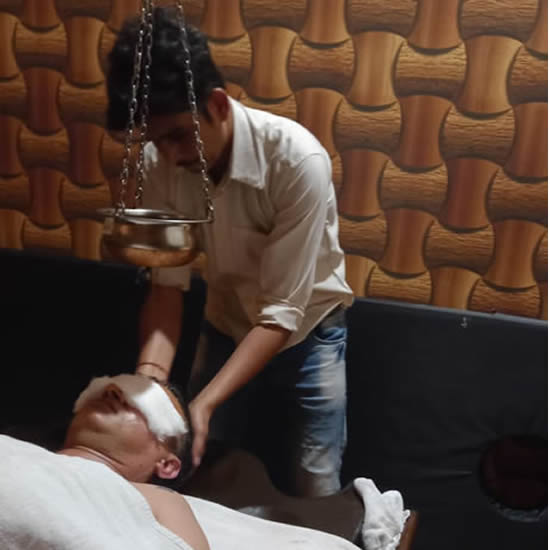PANCHAKARMA
Ayurvedic cleansing method
Panchakarma is one of the important part of ayurveda, which we can say the rejuvenation part of this natural and herbal practice, which eases the mental and physical health and connecting closer to spiritual development at the same time.
Panchakarma stages:
Panchkarma consists of three stages –
- Purvakarma (preparation before panchkarma)
- Pradhankarma (basic procedures)
- Paschatkarma (steps to follow after panchkarma).
Procedures to be carried out in the clinic:
According to the ayurvedic doctor (vaidya)-
- Abyanga- oil massage
- Swedana -steam bath
- Basti- kati basti, janu basti, greeva basti, hriday basti
- Vaman emetic therapy
- Virechan-bowel cleansing therapy
- Shirodhara – a procedure in which a trickle of oil is directed to the forehead
- Nasya-procedure for cleansing the nose and nasal passages
- Patra Potali- Pinda sevdan- reducing pain
- Takradhara- butter milk and herbs as shirodhara in summer season
- Enema therapy
In addition, if any other procedure retired and prescribed by Vaidya.


Day wise Schedule
In the morning, Vedic lectures on Yoga, Ayurveda, Panchakarma are planned. Afternoon – a visit to various interesting, cultural, spiritual, other important places and, in the end, summing up the educational part of the trip.
Day 1
- 07:30 – 9:00 – Pulse diagnosis and meditation training
- 9:00 – 10:00 – Breakfast
- 10:00 -12: 00 – Lectures on Ayurveda and meditation
- 12:30 – 13:30 – Lunch
- 13:30AM 15:00 – Lectures and practice in Ayurveda
- 15:00 – Tea
- 15:30 – 18:00 – Visit to the Puja on the Ganges
- 18h – 19:45 – Treatment
- 20:00 – Dinner
Day 2
- 7:30 – 9:00 – Continuation of the discussion of the topic of Ayurveda, meditation.
- 9:00 – 10:00 – Breakfast
- 10:00 – 12:00 –Lectures
- 12:30 – 13:30 – Lunch
- 13:30 – Drive to Haridwar
- 15:00 – tea in Haridwar and visit to puja (Ganga-Arti)
- 20:00 – Dinner
Day 3
- 7:30 -9: 00 – Continuation of lectures on Ayurveda
- 9:00 – 10:00 – Breakfast
- 10:00 – 12:00 – Pulse diagnostics (practice)
- 12:30 – 13:30 – Lunch
- 13:30 – 15:30 – Lecture on Ayurveda
- 15:00 – Tea
- 15:30 – 18:00 – Visit to the Vashisht Gufa
- 18:00 – 20:00 – Treatment
- 20:00 – Dinner
Day 5
- 7:30 – 9:00 – Introduction to yoga meditation and practice of some postures
- 9:00 – 10:00 – Breakfast
- 10:00 – 12:00 – Discussion of the benefits of postures practiced in the morning
- 12:30 – 13:30 – Lunch
- 13: 30 – 15:00 – Conversation on yoga
- 15:00 – Tea
- 15:30 – 18:00 – Visit to yoga ashrams
- 18:00 – 20:00 – Treatment
DAy 4
- 7:30 – 9:00 – Introduction to yoga and the practice of some asanas
- 9:00 – 10:00 – Breakfast
- 10:00 – 12:00 – Lecture on yoga
- 12:30 – 13:30 – Lunch
- 13: 30 – 15:00 – Workshop on yoga, practice
- 15:00 – Tea
- 15:30 – 18:00 – Treatment
- 1 18:00 – 20:00 – yoga procedures
- 20:00 – Dinner
Panchakarma is a key component of Ayurvedic medicine, an ancient system of health and wellness originating from India. The term “Panchakarma” translates to “five actions” or “five treatments,” and these treatments are designed to detoxify and rejuvenate the body. The five therapies are:
Vamana (Therapeutic Vomiting): This treatment helps expel excess mucus and toxins from the upper digestive tract and lungs. It’s usually performed when there is a need to clear out accumulated Kapha dosha (one of the three doshas, or body energies, in Ayurveda).
Virechana (Purgation): This process involves the use of herbal laxatives to cleanse the lower digestive tract and intestines. It’s aimed at removing excess Pitta dosha and is used for conditions related to digestive…
[01:17, 8/5/2024] Anand rishikesh Writing: Nasya (Nasal Administration): This treatment involves administering herbal oils or powders through the nasal passages. It helps to clear toxins from the head and neck region and can benefit conditions like sinusitis, headaches, and allergies.
Raktamokshana (Blood Letting): This is the practice of removing a small amount of blood to detoxify the body and balance the doshas. It’s less commonly used today but may be applied in specific cases of blood disorders or toxicity.
Panchakarma treatments are typically preceded by a preparatory phase called Purvakarma, which involves procedures like Snehana (oil massage) and Swedana (steam therapy) to loosen and mobilize toxins. After the primary treatments, a Rasayana or rejuvenation phase helps restore balance and strengthen the body.
Overall, Panchakarma is personalized based on an individual’s unique constitution and health conditions. It’s best performed under the guidance of a trained Ayurvedic practitioner to ensure safety and effectiveness.

